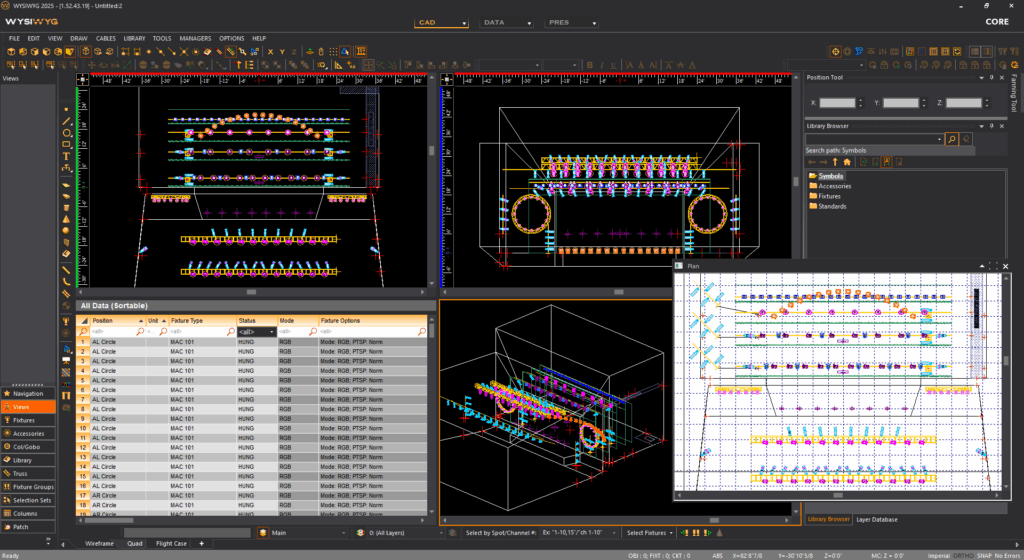Summary
WYSIWYG Lighting is a revolutionary software tool developed by CAST Software, designed to change how lighting professionals plan, visualize, and execute their designs in real-world applications. The name “WYSIWYG” stands for What You See Is What You Get, which perfectly captures the software’s philosophy providing a real-time, true-to-life visualization of how lighting setups will appear in performance environments. Used by lighting designers, stage technicians, architects, and entertainment professionals, WYSIWYG Lighting serves as a complete solution that combines pre-visualization, lighting design, and virtual rendering into one powerful system.
Its ability to simulate realistic lighting behavior, including color, shadows, and reflections, helps professionals refine their concepts long before the actual installation or live event. With the evolution of the entertainment industry and digital production demands, WYSIWYG Lighting has become an essential tool for bringing creativity and precision together, ensuring that every beam, shadow, and focus point aligns perfectly with the designer’s artistic vision.
Understanding the Core of WYSIWYG Lighting
WYSIWYG Lighting functions as a comprehensive lighting design and visualization platform that merges the power of technical accuracy with artistic control. It allows users to construct detailed 3D environments, populate them with lighting fixtures, and manipulate every variable intensity, angle, color, focus, and position to create a fully realized lighting design before implementation. The software is built on an advanced rendering engine that produces real-time visual feedback, enabling designers to view the results instantly as they make adjustments. This feature eliminates guesswork and helps minimize on-site setup time and costs.
WYSIWYG supports an extensive database of lighting fixtures, gobos, and effects from leading manufacturers, ensuring realistic behavior that mirrors actual hardware performance. By integrating DMX protocols and connectivity to lighting consoles, designers can test their cues and programming within the virtual environment, making WYSIWYG an invaluable asset for pre-production planning, visualization, and execution across entertainment venues, theaters, and broadcast environments.
The Power of Pre-Visualization
Pre-visualization is the cornerstone of WYSIWYG Lighting’s functionality. Before the actual rigging or setup occurs, designers can build a detailed virtual model of the stage or venue, complete with trusses, scenery, and performers. They can then place lighting fixtures within the scene and experiment with different lighting setups, transitions, and effects to determine what works best. The ability to pre-visualize in real-time not only saves time during the actual setup but also allows lighting professionals to identify and resolve potential issues early in the design process.
Real-Time Rendering and Accuracy
One of the most impressive aspects of WYSIWYG Lighting is its real-time rendering engine. This powerful system allows users to see exactly how lighting effects will appear, with precise representation of brightness, reflection, and atmospheric effects. Whether it’s haze diffusion, beam spread, or light bounce, every visual element is calculated with photometric accuracy, ensuring that what designers see on screen is what audiences will experience live. The software uses advanced algorithms to simulate natural light physics, providing a visual output that matches real-world conditions under varying lighting scenarios. This level of precision makes it an essential tool not only for entertainment designers but also for architects and lighting engineers who need to predict how lighting will interact with physical spaces.
Integration with Lighting Consoles and DMX Protocols
WYSIWYG Lighting’s compatibility with industry-standard lighting consoles and DMX control systems makes it a practical and powerful addition to any lighting workflow. Designers can connect their consoles directly to WYSIWYG and run live programming sessions as if they were controlling physical lights in a real venue. This interactivity helps programmers refine cue sequences, transitions, and timing before they step on-site, dramatically reducing the time spent on setup and troubleshooting. The software supports major lighting console brands, including MA Lighting, ETC, and High End Systems, among others, providing seamless integration and communication between virtual and physical systems.
Fixture Libraries and Realistic Lighting Behavior
Another significant strength of WYSIWYG Lighting lies in its comprehensive fixture library. The software includes thousands of lighting instruments and effects from leading manufacturers, all with accurate photometric data. This ensures that each fixture behaves in the virtual environment exactly as it would in reality, from color temperature to beam shape and focus range. Designers can explore different fixtures to see how they contribute to a scene, experiment with lighting angles, and test combinations of colors and gobos without needing physical equipment. The realistic lighting behavior simulated in WYSIWYG helps ensure that the designer’s creative decisions translate perfectly during the actual setup, minimizing adjustments during rehearsals.
Advanced Tools for Visualization and Design
WYSIWYG Lighting offers a range of advanced tools that streamline the visualization and design process. Its built-in CAD tools allow users to construct accurate 3D models of venues, trusses, and stage layouts with millimeter-level precision. The software also features measurement utilities, collision detection, and geometry alignment systems that simplify complex designs. In addition to standard visualization, WYSIWYG supports Design, Perform, and Report modes that cater to different stages of production. In Design mode, users can plan fixtures and layouts, while Perform mode allows for live control and testing.
Future of WYSIWYG and Lighting Innovation
As the lighting industry continues to evolve with advancements in LED technology, real-time rendering, and augmented reality, WYSIWYG Lighting remains at the forefront of innovation. CAST Software continues to expand its capabilities by integrating more accurate rendering techniques, improved hardware acceleration, and cloud-based collaboration tools. Future versions of WYSIWYG are expected to incorporate virtual production workflows, allowing designers to work within extended reality (XR) environments for immersive stage design. The growing emphasis on sustainability also means that pre-visualization tools like WYSIWYG will play a critical role in reducing energy consumption by optimizing designs before actual deployment.


